Hi,
can somebody please show me a clean and simple example on how to measure elapsed time between two events? Good if it is vanilla compatible too. I am trying to set up a basic gate to filter out fast triggering.
Cheers 
Debouncing (was measure time between two bangs/events)
Hi,
can somebody please show me a clean and simple example on how to measure elapsed time between two events? Good if it is vanilla compatible too. I am trying to set up a basic gate to filter out fast triggering.
Cheers 
Hi,
thank you for your input and help! timegate.pd is sort if how I pictured it and it seems to work great for me. There is absolutely a use for the debounce one too, so I will save that one.
I intend to use this function to reduce a jitter problem I have with using (real life) switches with the digital inputs of an Arduino (with pduiono). When the switch release from HI position to LOW I get additional HI triggers, it seems. I suspect that this is unavoidable hence the need for a jittergate.
My own triggate.pd was intended to work as timegate.pd, but worked as debounce.pd, but it was mostly luck I think. The key it seems is to really know how the timing flow of pd works. It seems lite timegate.pd (and other patches) can be so compact is because an object like |t b  sends the bangs in a specific order, right to left. So at each trig for the timegate there is actually two operations for |realtime|: First it sends the time from the last reset, and immediately after it restarts the counter. I was trying to achieve this in different ways and I knew it should be a clean way of doing it!
sends the bangs in a specific order, right to left. So at each trig for the timegate there is actually two operations for |realtime|: First it sends the time from the last reset, and immediately after it restarts the counter. I was trying to achieve this in different ways and I knew it should be a clean way of doing it!
Here is my try just for reference. I think it worked just because I happened to make the connections in the right sequence.
testing_triggate_example.pd
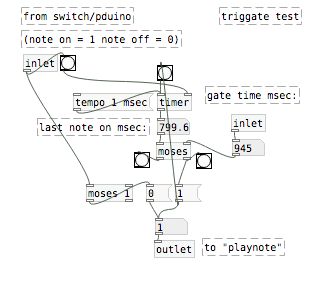

@weightless I suppose it is fun re-inventing the [debounce] and [block-bang] abstractions from extended....
...... should keep us going for a few years.
Don't misunderstand me...... I enjoy it too....
And often there are a good selection to choose from as they were doing the same as us even back in the early days......
David.
@whale-av It's been such a long time since I used extended that I don't even remember all that was available but I'm sure that 90% of the basic abstractions I've made over the last few years have been done already multiple times. I think It's a shame that there is no organised way to find externals and collections of abstractions, and perhaps a searchable index would be even better than externals coming pre-packaged with Pd. This would prevent us from having to reinvent a lot of wheels for sure.
one more thing, a logic one.
How do I set it up to only filter a quick 1 after 0, but not a quick 0 after 1?
Input and output will be either 1 or 0.
@cfry I'll give it a shot: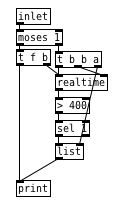
filter1.pd
@weightless I agree..... but I really don't know how it could be indexed considering the infinite possibilities in Pd.
I keep a copy of extended in a folder and just text search for likely "names". They were pretty well named in the olden days as the obvious name could still be used..... but there are still a lot of [same-sames]
The most fun now is building abstractions for vanilla to replace now incompatible objects from extended.
David.
@weightless
filter1.pd works well, thanks a lot! Going live tomorrow 
@cfry Great, good luck with your performance!
And since you are talking about the triggers comming out of an Arduino, the switches, you can use the debounce inside the arduino sketch, this is a different look at the solution.
@arpPDpi
Yes, that seems like an possible even better solution. I have so far only made a few simple programming tests on the Arduino and in this case I use the Firmata firmware, so I figured trying to add a debounce function to it would be too bold.
But maybe it would not be that complicated?
@cfry Also....... 50cents for 6 buttons....... because...... how long can you bounce my dear switch?
https://hackaday.com/2015/12/09/embed-with-elliot-debounce-your-noisy-buttons-part-i/
David.
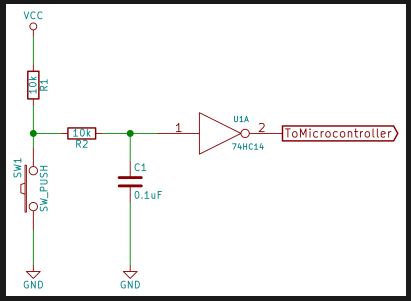
@whale-av cool, need to try the hardware solution next round. Great article!
@whale-av said:
@cfry Also....... 50cents for 6 buttons....... because...... how long can you bounce my dear switch?
https://hackaday.com/2015/12/09/embed-with-elliot-debounce-your-noisy-buttons-part-i/
Hi,
I am necromancing this thread a bit. 
I have chosen to debounce in hardware (also, cause I will need to do in Pd too it seems).
I asked about this at the ardunio forum as well, but they suggest (naturally) that I solve it in the arduino code. Since I use the firmata combined with pduino I can not do that.
I would like some help please with choosing the right hardware debouncing configuration. It works pretty ok as of now, but I want to make sure I do not make any errors in selecting electronics. I am debouncing the digital inputs of an arduino nano clone. It seems that I get quite different bouncing on the different inputs.
I am following this guide:
A Guide to Debouncing - Part 2, or, How to Debounce a Contact in Two Easy Pages, by Jack Ganssle
I am choosing between these two configurations:
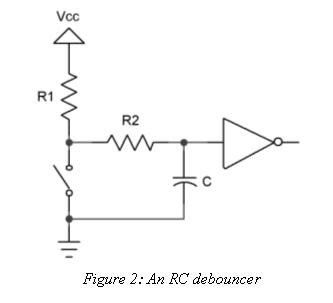
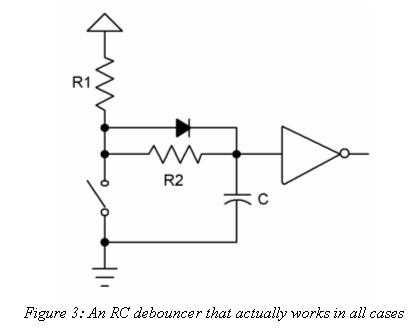
The math equations are beyond my understanding (I need to get a math textbook sooner or later, to brush up on things).
The latter, with the diode seems to work fine. Suggested values are C: 1 µF, R1: 82K, R2: 18K. I use slightly larger values.
The one without a diode, have example values C: 0.1 µF, R1:? (I used 10K), R2: 185K.
Question
Since I ran out of C 1µF, I used the values from the first circuit, but combined with a diode as in the second circuit. Does this make sense?
Thank you!
@cfry If the diode circuit works well....... and you know the correct values.... then you should source some more 1uf electrolytic capacitors and go with that.
R1 controls the rise time (back to Vcc) and R2 the fall time (to ground).
With the diode the rise time is faster than the fall time as R2 is bypassed.
But there is a handy time calculator for the time to charge the capacitor here...... https://www.digikey.fr/en/resources/conversion-calculators/conversion-calculator-time-constant?
...... so you can see the time with the correct values and work out what resistor value you need if you change the capacitor.
The chip probably has a very high input resistance in which case you can ignore it for your calculations.
None of it makes sense to me because my car squeaks on its own when it hits a pothole, and I will never want an augmented soundscape.
David.
@whale-av Thanks for the explanation and the link. I was using 1uF ceramic ones, why is it better with electrolytic?
And also thanks for the review  I did have second thoughts about showing the project, instead of just talking pd. My intention was not to confuse, actually the opposite. But it makes me curious, what makes sense to you?
I did have second thoughts about showing the project, instead of just talking pd. My intention was not to confuse, actually the opposite. But it makes me curious, what makes sense to you?
@cfry Ha ha, @whale-av was just making a joke about his car. I think it looks really cool, and I'm sure David does too. Glad you posted it.
Having that spring coil hit the top of that machine screw is very steam punk, but my instinct would be to use an IR reflectance sensor. No banging, lasts longer, probably less fun though.
@cfry Sorry, it was just a joke.
The diagram shows electrolytic capacitors. But they are just smaller for the same value..... so as you have the space it doesn't matter. Sorry again to confuse things.
It looks great. I think we are like minded and that is probably true of convinced Pd'ers...... imagining what we can do with what we have available.
David.
Since Pd 0.50 see [slop~] for de-bouncing control data from noisy switches...... [pd jitter-remover] ....... (amongst other uses).
David.
Oops! Looks like something went wrong!